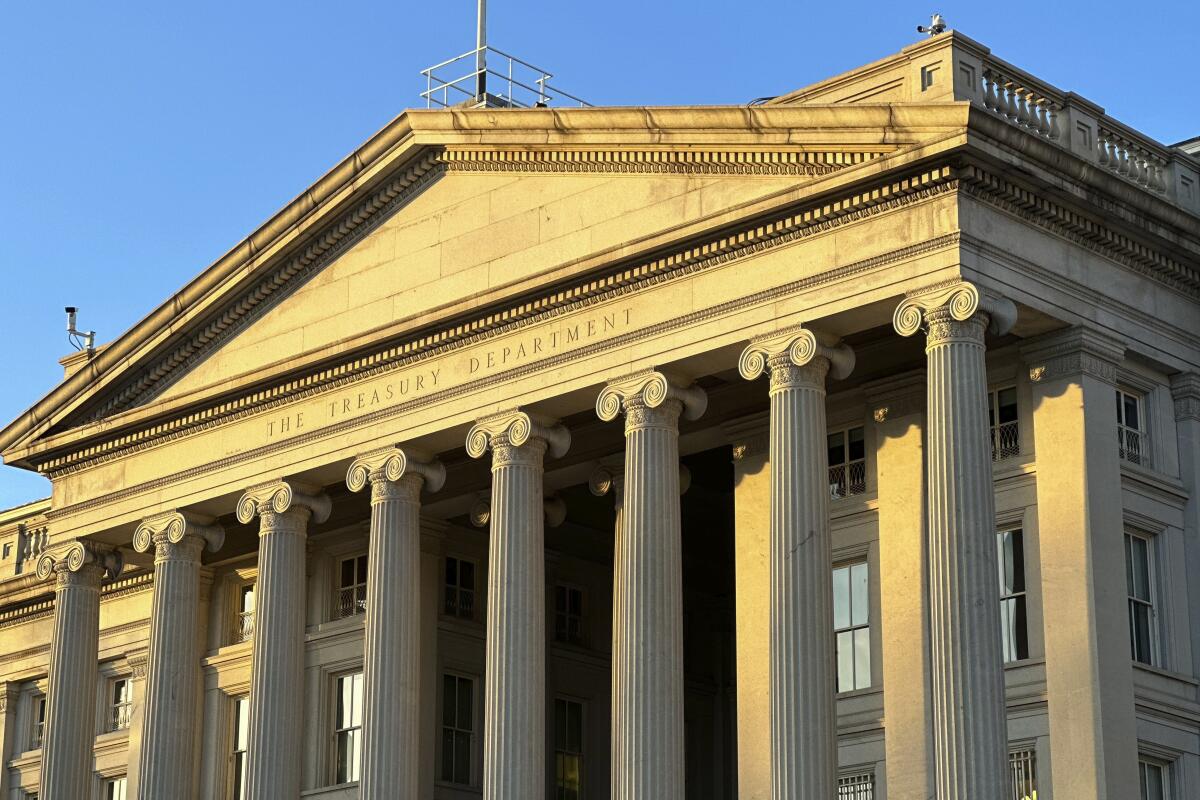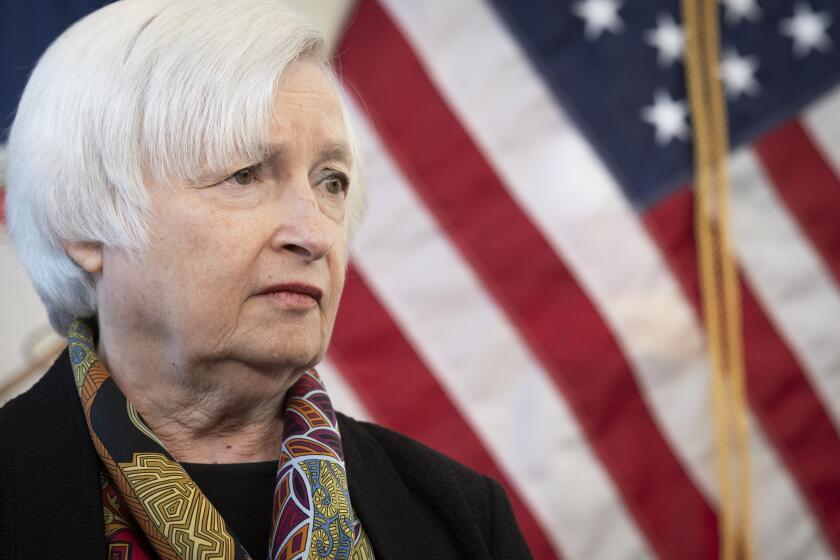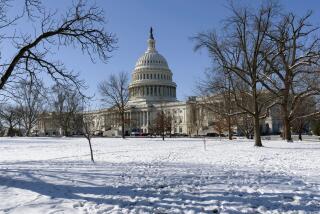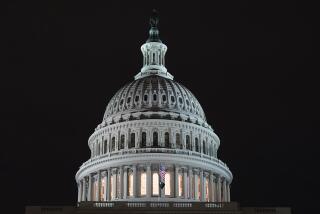U.S. Treasury buys time for Biden and GOP on debt limit deal

WASHINGTON — The U.S. government bumped up against its debt limit Thursday, prompting the Treasury Department to take “extraordinary” accounting steps to avoid default — as friction between President Biden and House Republicans raised concern about whether the U.S. can sidestep an economic crisis.
For the record:
9:19 a.m. Jan. 19, 2023An earlier version of this article stated the debt limit was $38.381 trillion. It is $31.381 trillion.
The Treasury Department said in a letter to congressional leaders that it has started taking “extraordinary measures” as the government has run up against its legal borrowing capacity of $31.381 trillion. An artificially imposed cap, the debt ceiling has been increased about 80 times since the 1960s.
“I respectfully urge Congress to act promptly to protect the full faith and credit of the United States,” Treasury Secretary Janet L. Yellen wrote in the letter.
Markets were relatively calm, given that the government can temporarily rely on accounting tweaks to stay open and any threats to the economy would be several months away. Even many worried analysts assume that there will be a deal.
But this particular moment seems more fraught than past brushes with the debt limit because of the broad differences between Biden and new House Speaker Kevin McCarthy, who presides over a restive Republican caucus.
Those differences increase the risk that the government could default on its obligations for political reasons. That could rattle financial markets and plunge the world’s largest economy into a preventable recession.
Biden and McCarthy (R-Bakersfield) have several months to reach agreement as the Treasury Department imposes extraordinary measures to keep the government operating until at least June. But years of intensifying partisan hostility have led to a conflicting set of demands that jeopardize the ability of the lawmakers to work together on a basic duty.
The federal government is on the brink of hitting its legal borrowing limit and is resorting to ‘extraordinary measures’ to avoid a default. Here’s what that means.
Biden insists on a “clean” increase to the debt limit so that existing financial commitments can be sustained and is refusing to even start talks with Republicans. McCarthy is calling for negotiations that he believes will lead to spending cuts. It’s unclear how much he wants to trim and whether fellow Republicans would support any deal after a testy start to the new Congress that required 15 rounds of voting to elect McCarthy as speaker.
Asked twice Wednesday whether there was evidence that House Republicans can ensure that the government would avert a default, White House Press Secretary Karine Jean-Pierre said it’s their “constitutional responsibility.” She did not say whether the White House saw signs at this stage that a default was off the table.
“We’re just not going to negotiate that,” Jean-Pierre said. “They should feel the responsibility.”
McCarthy said Biden needs to recognize the political realities that come with a divided government. The speaker equates the debt ceiling to a credit card limit and calls for a level of fiscal restraint that did not occur under President Trump, a Republican who in 2019 signed a bipartisan suspension of the debt ceiling.
“Why create a crisis over this?” McCarthy said this week. “I mean, we’ve got a Republican House, a Democratic Senate. We’ve got the president there. I think it’s arrogance to say, ‘Oh, we’re not going to negotiate about pretty much anything’ and especially when it comes to funding.”
Senate Republican Leader Mitch McConnell of Kentucky said Thursday that he was unconcerned about the situation because debt ceiling increases are “always a rather contentious effort.”
“America must never default on its debt,” McConnell said. “We’ll end up in some kind of negotiation with the administration over what are the circumstances or conditions under which the debts are going to be raised.”
But any deal would need to pass the Democratic-run Senate. Many Democratic lawmakers are skeptical about the ability to work with Republicans aligned with the “Make America Great Again” movement started by Trump. The MAGA movement has claimed that the 2020 election lost by Trump was rigged, a falsehood that contributed to the Jan. 6, 2021, insurrection at the U.S. Capitol.
Treasury Secretary Janet L. Yellen said the U.S. is projected to reach its debt limit Thursday and will then use ‘extraordinary measures’ to avoid default.
“This is not complicated: If the MAGA GOP stops paying our nation’s bills, Americans will be the ones to pay the price,” said Senate Majority Leader Charles E. Schumer (D-N.Y.). “Political brinkmanship with the debt limit would be a massive hit to local economies, American families, and would be nothing less than an economic crisis at the hands of the Republicans.”
The debt ceiling was originally a fix made during World War I that enabled bonds to be issued without getting repeated congressional approvals. But in an era of polarization and rising debt loads, the limit has been transformed into a political bludgeon. It does not reflect the actual capacity of the federal government to borrow, simply how much it is legally able to do so without congressional approval.
In order to keep the government open, the Treasury Department on Thursday made a series of accounting maneuvers that would put a hold on contributions and investment redemptions for government workers’ retirement and healthcare funds, giving the government enough financial space to handle its day-to-day expenses until roughly June.
What happens if these measures are exhausted without a debt limit deal is unknown. A prolonged default could be devastating, with crashing markets and panic-driven layoffs if confidence evaporated in a cornerstone of the global economy, the U.S. Treasury note.
Analysts at Bank of America cautioned in a report last week that “there is a high degree of uncertainty about the speed and magnitude of the damage the U.S. economy would incur.”
The underlying challenge is that the government would have to balance its books on a daily basis if it lacks the ability to issue debt. If the government cannot issue debt, it would have to impose cuts equal in size on an annual basis to 5% of the total U.S. economy. Analysts say their baseline case is that the U.S. avoids default.
Still, if past debt ceiling showdowns such as the one that occurred in 2011 are any guide, Washington may be in a nervous state of suspended animation with little progress until the “X-date,” the deadline when the Treasury’s extraordinary measures are depleted.
Unlike the 2011 showdown, the Federal Reserve is actively raising interest rates to lower inflation and is rolling off its own holdings of U.S. debt, meaning that recession fears are already elevated among consumers, businesses and investors.
Biden administration officials have said they will not prioritize payments to bondholders if the country passes the “X-date” without an agreement. Over the years, officials have studied this emergency option, which Treasury officials across administrations have said is unworkable because of the government’s payments system.
“To some extent, the ‘extraordinary measures’ are the backup plan, and once those are exhausted the next step is a major question mark,” economists at Wells Fargo wrote in a Thursday analysis.
Associated Press writer Lisa Mascaro contributed to this report.
More to Read
Get the L.A. Times Politics newsletter
Deeply reported insights into legislation, politics and policy from Sacramento, Washington and beyond. In your inbox three times per week.
You may occasionally receive promotional content from the Los Angeles Times.











